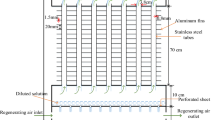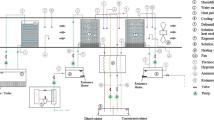Abstract
In hot and moist weather, a hybrid liquid desiccant dehumidification conditioning (LDAC) system is proposed as a viable substitute to stand-alone conventional vapour compression refrigeration (VCR) system because of their dominance in extracting the latent heat load from the air, being environmentally friendly, removing pollutants from the processed air, and consuming less electrical energy. The current research article experimentally investigates the dehumidification performance of a potassium formate (KCOOH) solution on an innovatively designed and developed 5-kW hybrid LDAC system. The main aim of this research paper is to optimize the performance parameters of a hybrid LDAC system employing a full factorial DOE design. The three input variables are selected to evaluate their effects on the three output performance responses. The regression correlation is obtained to anticipate the performance of the KCOOH solution for the output responses. The experimental result reveals that their improvement of 26.97% in \({\mathrm{COP}}_{{{\mathrm{Hybrid}}}}\) as compared to a stand-alone VCR unit and that the influence of inlet desiccant concentration is more prominent than the inlet mass flow rate and inlet desiccant temperature on the output responses.









Similar content being viewed by others
Abbreviations
- AC:
-
Air conditioner
- ANOVA:
-
Analysis of variance
- C:
-
Desiccant concentration (\({\mathrm{kg}}_{{{\mathrm{desiccant}}}} /{\mathrm{kg}}_{{{\mathrm{solution}}}}\))
- COP:
-
Coefficient of performance
- \({\mathrm{COP}}_{{{\mathrm{Hybrid}}}}\) :
-
Coefficient of performance of a hybrid system
- DOE:
-
Design of experiments
- HE-1:
-
Heat exchanger 1
- HE-2:
-
Heat exchanger 2
- IAQ:
-
Indoor air quality
- LDAC:
-
Liquid desiccant air-conditioning
- LHL:
-
Latent heat load
- KCOOH:
-
Potassium formate
- TR:
-
Ton of refrigeration
- VCR:
-
Vapour compression refrigeration
- \(a_{1} {-} a_{7}\) :
-
Air states points
- d 1–d 4 :
-
Desiccant solution state points
- DA:
-
Dry air
- \(\dot{m}_{a11}\) :
-
Inlet mass flow rate at level 1
- \(\dot{m}_{a12}\) :
-
Inlet mass flow rate at level 2
- \(\dot{m}_{a13}\) :
-
Inlet mass flow rate at level 3
- sys:
-
System
- T :
-
Temperature (K)
- \(T_{d11}\) :
-
Inlet desiccant temperature at level 1
- \(T_{d12}\) :
-
Inlet desiccant temperature at level 2
- \(T_{d13}\) :
-
Inlet desiccant temperature at level 3
- \(C_{11}\) :
-
Inlet desiccant concentration at level 1
- \(C_{12}\) :
-
Inlet desiccant concentration at level 2
- \(C_{13}\) :
-
Inlet desiccant concentration at level 3
- \(\Delta w\) :
-
Specific humidity change
- \(w\) :
-
Specific humidity
- \(\emptyset\) :
-
Relative humidity
References
Che, W.W., et al.: Energy consumption, indoor thermal comfort and air quality in a commercial office with retrofitted heat, ventilation and air conditioning (HVAC) system. Energy Build. 201, 202–215 (2019). https://doi.org/10.1016/J.ENBUILD.2019.06.029
Anand, P.; Sekhar, C.; Cheong, D.; Santamouris, M.; Kondepudi, S.: Occupancy-based zone-level VAV system control implications on thermal comfort, ventilation, indoor air quality and building energy efficiency. Energy Build. 204, 109473 (2019). https://doi.org/10.1016/J.ENBUILD.2019.109473
Naik, B.K.; Muthukumar, P.: Experimental investigation and parametric studies on structured packing chamber based liquid desiccant dehumidification and regeneration systems. Build. Environ. 149, 330–348 (2019). https://doi.org/10.1016/J.BUILDENV.2018.12.028
Prasartkaew, B.; Kumar, S.: A low carbon cooling system using renewable energy resources and technologies. Energy Build. 42(9), 1453–1462 (2010). https://doi.org/10.1016/J.ENBUILD.2010.03.015
Zhang, Y.; Zhou, G.; Lin, K.; Zhang, Q.; Di, H.: Application of latent heat thermal energy storage in buildings: state-of-the-art and outlook. Build. Environ. 42(6), 2197–2209 (2007). https://doi.org/10.1016/J.BUILDENV.2006.07.023
Dai, Y.J.; Wang, R.Z.; Zhang, H.F.; Yu, J.D.: Use of liquid desiccant cooling to improve the performance of vapor compression air conditioning. Appl. Therm. Eng. 21(12), 1185–1202 (2001). https://doi.org/10.1016/S1359-4311(01)00002-3
Mohan, B.S.; Tiwari, S.; Maiya, M.P.: Experimental investigations on performance of liquid desiccant-vapor compression hybrid air conditioner. Appl. Therm. Eng. 77, 153–162 (2015). https://doi.org/10.1016/J.APPLTHERMALENG.2014.12.004
Khalil, A.: An experimental study on multi-purpose desiccant integrated vapor-compression air-conditioning system. Int. J. Energy Res. 36(4), 535–544 (2012). https://doi.org/10.1002/er.1767
Mohammad, A.T.; Bin Mat, S.; Sulaiman, M.Y.; Sopian, K.; Al-Abidi, A.A.: Survey of hybrid liquid desiccant air conditioning systems. Renew. Sustain. Energy Rev. 20, 186–200 (2013). https://doi.org/10.1016/J.RSER.2012.11.065
Misha, S.; Mat, S.; Ruslan, M.H.; Sopian, K.: Review of solid/liquid desiccant in the drying applications and its regeneration methods. Renew. Sustain. Energy Rev. 16(7), 4686–4707 (2012). https://doi.org/10.1016/J.RSER.2012.04.041
Abdel-Salam, A.H.; Simonson, C.J.: State-of-the-art in liquid desiccant air conditioning equipment and systems. Renew. Sustain. Energy Rev. 58, 1152–1183 (2016). https://doi.org/10.1016/J.RSER.2015.12.042
La, D.; Dai, Y.J.; Li, Y.; Wang, R.Z.; Ge, T.S.: Technical development of rotary desiccant dehumidification and air conditioning: a review. Renew. Sustain. Energy Rev. 14(1), 130–147 (2010). https://doi.org/10.1016/j.rser.2009.07.016
Longo, G.A.; Gasparella, A.: Experimental and theoretical analysis of heat and mass transfer in a packed column dehumidifier/regenerator with liquid desiccant. Int. J. Heat Mass Transf. 48(25–26), 5240–5254 (2005). https://doi.org/10.1016/J.IJHEATMASSTRANSFER.2005.07.011
Lof GOG, B.T.; Cler, G.: Performance of a solar desiccant cooling system. In: Proceedings ASME-JSME-JSES Solar Energy Conference Honolulu, Hawaii, USA, pp. 828–834 (1986)
Elsarrag, E.: Performance study on a structured packed liquid desiccant regenerator. Sol. Energy 80(12), 1624–1631 (2006). https://doi.org/10.1016/J.SOLENER.2005.11.005
Liu, X.H.; Yi, X.Q.; Jiang, Y.: Mass transfer performance comparison of two commonly used liquid desiccants: LiBr and LiCl aqueous solutions. Energy Convers. Manag. 52(1), 180–190 (2011). https://doi.org/10.1016/J.ENCONMAN.2010.06.057
Wen, T.; Luo, Y.; Sheng, L.: Experimental study on the corrosion behavior and regeneration performance of KCOOH aqueous solution. Sol. Energy 201(2018 May), 638–648 (2020). https://doi.org/10.1016/j.solener.2020.03.044
Cheng, X.; Yin, Y.; Guo, Y.; Zhou, W.: Experimental study on a novel air conditioning system for deep cascade utilization of waste heat. Appl. Therm. Eng. 200, 117695 (2022). https://doi.org/10.1016/J.APPLTHERMALENG.2021.117695
Wen, T.; Luo, Y.; Wang, M.; She, X.: Comparative study on the liquid desiccant dehumidification performance of lithium chloride and potassium formate. Renew. Energy 167, 841–852 (2021). https://doi.org/10.1016/J.RENENE.2020.11.157
Shi, Y.; Chen, G.: Experimental study of falling film absorption with potassium formate—water as working pair. Int. J. Therm. Sci. 176, 107520 (2022). https://doi.org/10.1016/J.IJTHERMALSCI.2022.107520
Zhang, N., et al.: Numerical investigations and performance comparisons of a novel cross-flow hollow fiber integrated liquid desiccant dehumidification system. Energy 182, 1115–1131 (2019). https://doi.org/10.1016/J.ENERGY.2019.06.036
Longo, G.A.; Gasparella, A.: Experimental measurement of thermophysical properties of H2O/KCOOH (potassium formate) desiccant. Int. J. Refrig. 62, 106–113 (2016). https://doi.org/10.1016/J.IJREFRIG.2015.10.004
Wang, Z.; Zhang, X.; Li, Z.: Investigation on the coupled heat and mass transfer process between extremely high humidity air and liquid desiccant in the counter-flow adiabatic packed tower. Int. J. Heat Mass Transf. 110, 898–907 (2017). https://doi.org/10.1016/J.IJHEATMASSTRANSFER.2017.03.072
Chen, X., et al.: Experimental investigation of a polymer hollow fibre integrated liquid desiccant dehumidification system with aqueous potassium formate solution. Appl. Therm. Eng. 142, 632–643 (2018). https://doi.org/10.1016/J.APPLTHERMALENG.2018.07.003
Wen, T.; Luo, Y.; Sheng, L.: Experimental study on the corrosion behavior and regeneration performance of KCOOH aqueous solution. Sol. Energy 201, 638–648 (2020). https://doi.org/10.1016/J.SOLENER.2020.03.044
Anderson, V.L.; McLean, R.A.: Design of Experiments: A Realistic Approach (2018). https://doi.org/10.1201/9781315141039
Mohr, D.L.; Wilson, W.J.; Freund, R.J.: Design of experiments. In: Mohr, D.L.; Wilson, W.J.; Freund, R.J. (Eds.) Statistical Methods, pp. 493–546. Academic Press, Cambridge (2022). https://doi.org/10.1016/B978-0-12-823043-5.00010-2
Kumar, R.; Dhar, P.L.; Jain, S.: Development of new wire mesh packings for improving the performance of zero carryover spray tower. Energy 36(2), 1362–1374 (2011). https://doi.org/10.1016/j.energy.2010.09.040
Longo, G.A.; Gasparella, A.: Three years experimental comparative analysis of a desiccant based air conditioning system for a flower greenhouse: assessment of different desiccants. Appl. Therm. Eng. 78, 584–590 (2015). https://doi.org/10.1016/J.APPLTHERMALENG.2014.12.005
Bassuoni, M.M.: Experimental performance study of a proposed desiccant based air conditioning system. J. Adv. Res. 5(1), 87–95 (2014). https://doi.org/10.1016/J.JARE.2012.12.002
Author information
Authors and Affiliations
Corresponding author
Rights and permissions
Springer Nature or its licensor (e.g. a society or other partner) holds exclusive rights to this article under a publishing agreement with the author(s) or other rightsholder(s); author self-archiving of the accepted manuscript version of this article is solely governed by the terms of such publishing agreement and applicable law.
About this article
Cite this article
Kumar, K., Singh, A. Estimating the Power Saving of KCOOH Liquid Desiccant Dehumidification System Using a Statistical Method. Arab J Sci Eng 48, 11441–11456 (2023). https://doi.org/10.1007/s13369-022-07482-1
Received:
Accepted:
Published:
Issue Date:
DOI: https://doi.org/10.1007/s13369-022-07482-1




